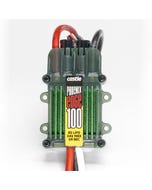An Electronic Speed Controller (ESC) is a device that regulates the power of an electric motor, allowing it to throttle from 0% to 100%. There are two styles of Electronic Speed Controller, Brushed and Brushless. Both work on the same principle.
An ESC is made up of three key components. A BEC/voltage regulator, a Processer and the switching consisting of FETs (field effect transistor). Now let's get a little technical.
The BEC/voltage regulator is a division of the ESC that will send a set amount of power (typically 5v 1Ah) back to your receiver to then power your servos. This also has a secondary function whereby if the battery that is driving the motor reaches its minimum voltage the BEC (Battery Eliminator Circuit) will reserve power for the flight critical controls, making sure the motor doesn't take all the power from the battery.
The processor is an integrated circuit that now days is completely contained in a single silicone semiconductor chip. Its job is to translate the information being given to it from the receiver in the model and switch the FETs to regulate the power to the motor. The FET is the component that is doing all the work in an ESC. It "sees" the full voltage and current of the battery and motor. A FET is essentially an electronic switch that chops up the flow of electricity that in turn throttles the motor.

The differences between Brushless and Brushed
A brushed motor is DC (Direct Current) and only required an ESC to have one "bank" (sometimes paralleled to multiply current capacity) of FETs. These simply chop up the flow of electricity to throttle the motor. Commutation is taken care of mechanically via the brushes and a sectioned commutator inside the motor.
A Brushless motor is a three-phase AC (Alternating Current) little more complex as they have three "banks" (sometimes paralleled to multiply current capacity) one for each phase. A Brushless motor is also always wound in a multiple of 3 and each group of windings are one phase. A brushless ESC throttles the motor a little differently to a brushed ESC as you have two components to how this works. You have the switching of phases whereby the electromagnetic field jumps from one phase to another pushing the magnets around the stator and the "volume" of electricity getting to the coils. The "volume" of electricity is taken care of in the same way as the brushed motor. We also add timing to a brushless motor. This is where a phase is powered and the feedback from the unpowered phases sends the location of the passing magnet letting the processor know the position of the rotor and maintaining correct timing. This is the reason why a Brushless motor will not work on a Brushed ESC and vice versa.
We hope this guide has helped you to understand how ESC's work. If you have any questions, please do not hesitate to contact us - our staff are always happy to help.



